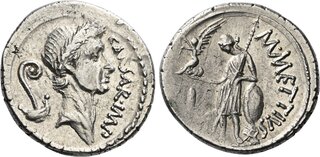| Numismatica Ars Classica > Auction 143 | Auction date: 7 May 2024 |
| Lot number: 380 Price realized: This lot is for sale in an upcoming auction - Bid on this lot  | Show similar lots on CoinArchives Find similar lots in upcoming auctions on |
| Lot description: The Dioscuri Collection. The Roman Republic. C. Iulius Caesar and M. Mettius. Denarius 44, AR 19 mm, 3.85 g. CAESAR·IMP Wreathed head of Caesar r.; behind, lituus and culullus. Rev. M METTIVS Venus standing l., holding sceptre and Victory, and resting l. elbow on shield which in turn rests on globe; in l. field, I. Babelon Julia 32 and Mettia 4. C 34. Sydenham 1056. Alföldi, Caesar, pl. XIII, 45 (these dies). Sear Imperators 100. RBW –. Crawford 480/3. Minor areas of weakness, otherwise good extremely fine Ex Tkalec 8 September 2008, 179 and Roma Numismatics 7, 2014, 970 sales. The early career of Julius Caesar, certainly the most famous of all Romans, was far from remarkable. He followed the standard cursus honorum of a nobleman, and had he not been struck by great ambition in his 31st year, he may have been little more than a footnote in history. Caesarís moment of clarity seems to have occurred while serving as a quaestor in Spain: he gazed upon a statue of Alexander the Great, who by age 31 had already conquered Greece and the Persian Empire. Within a few years Caesar had joined Crassus in a populist movement against the nobility, and a decade later was consul. From there his career spiralled to ever-rising heights, including the pacification of Gaul, the defeat of Pompey Magnus at Pharsalus, and receiving the unprecedented title dictator perpetuus from the Senate. However, shortly before he was to ask for the title of king in advance of his campaign against Parthia (for the Sibylline Books prophesied that only a king could conquer Parthia), Caesar was murdered by a group of senators led by Brutus and Cassius. So ended Caesar's life, but not his legacy, which was carried forth by Marc Antony and Octavian, and which survived in the form of the Julio-Claudians dynasty and the first six emperors of Rome. The peculiarity of the Roman monetary portraiture of this period lies in the absolutely realistic reproduction of the likeness of the personality portrayed. Julius Caesar is one of the first, if not the first, Roman who, while living, had himself immortalised on coins (excluding T. Quinctius Flaminius). The coins with the effigy of Julius Caesar alive are of easy and certain dating. Even though done by several artists, they show with different personal styles a faithful image of the general. On the specimen here offered, work of a highly talented engraver, preserved to perfection and well struck, are evident the folds of the neck that obliquely cover the sternocleidomastoid muscle, falling in parallel lines, and a vertical wrinkledness that clearly underlines the laryngo-thyroidal lump; moreover, an accentuation of the orbicular musculature of the mouth, matched by the prominence of the zygomatic arch. These observations are due to Sergio Macchi, a well-known and skilled doctor from Lugano, scholar of coins of the Roman Republic, who in an interesting article privately published but deserving to be brought out again in a widely-circulated numismatic review, starting from the monetary portrayals of Caesar, also supported with a new and more convincing interpretation of the historical sources, has come to the conclusion that the leader, at the time of the mintage of the coins, was suffering from a terminal abdominal tumour. This fascinating and intriguing hypothesis casts a new light upon those tormented times and the coin we offer here is one of the most palpable evidence. Estimate: 4000 CHF |  |



